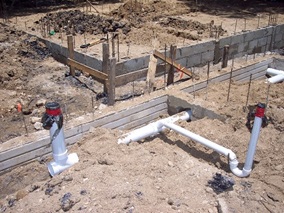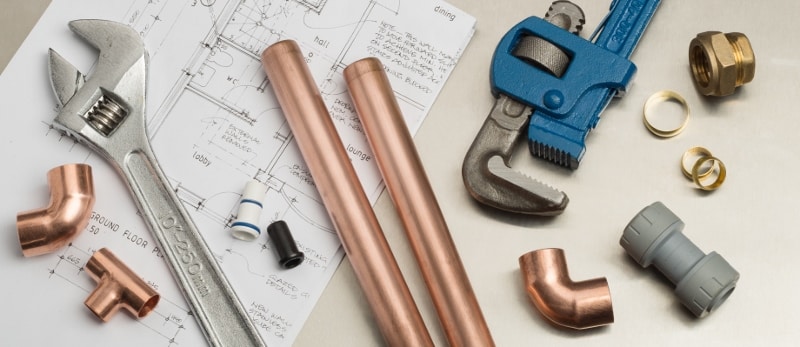We have discovered this article involving The Inner Workings of Your Home's Plumbing directly below on the net and thought it made perfect sense to relate it with you on this site.

Comprehending how your home's pipes system works is essential for every single property owner. From delivering clean water for alcohol consumption, cooking, and showering to securely eliminating wastewater, a properly maintained plumbing system is essential for your family's wellness and comfort. In this detailed guide, we'll discover the intricate network that composes your home's plumbing and deal pointers on maintenance, upgrades, and taking care of typical problems.
Intro
Your home's plumbing system is greater than just a network of pipes; it's a complicated system that guarantees you have access to clean water and reliable wastewater removal. Understanding its parts and how they collaborate can aid you prevent costly repairs and guarantee every little thing runs smoothly.
Fundamental Elements of a Pipes System
Pipes and Tubing
At the heart of your plumbing system are the pipelines and tubes that carry water throughout your home. These can be made from numerous materials such as copper, PVC, or PEX, each with its advantages in terms of durability and cost-effectiveness.
Fixtures: Sinks, Toilets, Showers, etc.
Components like sinks, commodes, showers, and bathtubs are where water is made use of in your home. Understanding exactly how these components attach to the plumbing system helps in identifying troubles and planning upgrades.
Valves and Shut-off Points
Shutoffs regulate the circulation of water in your pipes system. Shut-off shutoffs are essential during emergencies or when you need to make repairs, allowing you to isolate parts of the system without interrupting water circulation to the entire home.
Water System
Key Water Line
The main water line attaches your home to the municipal supply of water or a personal well. It's where water enters your home and is dispersed to numerous components.
Water Meter and Stress Regulatory Authority
The water meter actions your water use, while a stress regulatory authority makes certain that water flows at a safe pressure throughout your home's plumbing system, avoiding damage to pipes and fixtures.
Cold Water vs. Hot Water Lines
Understanding the distinction in between cold water lines, which provide water straight from the primary, and hot water lines, which lug warmed water from the hot water heater, aids in fixing and preparing for upgrades.
Drainage System
Drain Pipes Water Lines and Traps
Drain pipelines lug wastewater far from sinks, showers, and commodes to the drain or septic system. Catches avoid sewage system gases from entering your home and likewise catch particles that could create obstructions.
Air flow Pipes
Ventilation pipes enable air into the water drainage system, stopping suction that might slow drain and trigger traps to vacant. Proper ventilation is important for preserving the integrity of your pipes system.
Value of Correct Drain
Making certain appropriate drainage protects against back-ups and water damages. Consistently cleansing drains pipes and preserving catches can avoid expensive repairs and expand the life of your plumbing system.
Water Heating System
Types of Water Heaters
Water heaters can be tankless or traditional tank-style. Tankless heating units warmth water on demand, while storage tanks keep heated water for immediate use.
Updating Your Pipes System
Reasons for Updating
Upgrading to water-efficient components or replacing old pipes can boost water quality, minimize water costs, and enhance the worth of your home.
Modern Plumbing Technologies and Their Advantages
Check out innovations like clever leak detectors, water-saving bathrooms, and energy-efficient water heaters that can conserve money and lower environmental impact.
Expense Considerations and ROI
Determine the ahead of time costs versus lasting cost savings when thinking about pipes upgrades. Numerous upgrades spend for themselves with reduced utility costs and fewer fixings.
Exactly How Water Heaters Attach to the Plumbing System
Recognizing how hot water heater connect to both the cold water supply and warm water circulation lines helps in detecting issues like not enough hot water or leakages.
Upkeep Tips for Water Heaters
On a regular basis purging your water heater to get rid of debris, checking the temperature level settings, and checking for leakages can expand its life expectancy and enhance power efficiency.
Usual Pipes Problems
Leakages and Their Causes
Leakages can occur due to maturing pipes, loose installations, or high water stress. Dealing with leaks immediately protects against water damages and mold development.
Obstructions and Blockages
Blockages in drains pipes and toilets are frequently brought on by flushing non-flushable things or a buildup of grease and hair. Utilizing drainpipe displays and being mindful of what decreases your drains can stop obstructions.
Indicators of Plumbing Issues to Expect
Low water stress, slow-moving drains, foul odors, or uncommonly high water bills are indications of possible plumbing issues that need to be dealt with immediately.
Pipes Maintenance Tips
Routine Assessments and Checks
Arrange yearly pipes inspections to catch issues early. Try to find indicators of leaks, deterioration, or mineral buildup in faucets and showerheads.
Do It Yourself Upkeep Tasks
Simple tasks like cleaning tap aerators, looking for toilet leaks using dye tablet computers, or shielding exposed pipes in chilly environments can stop significant pipes problems.
When to Call a Specialist Plumbing Professional
Know when a pipes concern calls for specialist expertise. Trying intricate repair services without correct knowledge can bring about even more damages and greater repair service costs.
Tips for Reducing Water Use
Basic routines like taking care of leaks promptly, taking shorter showers, and running complete lots of washing and meals can save water and reduced your utility bills.
Eco-Friendly Plumbing Options
Take into consideration sustainable plumbing products like bamboo for flooring, which is durable and eco-friendly, or recycled glass for kitchen counters.
Emergency situation Preparedness
Steps to Take Throughout a Plumbing Emergency situation
Know where your shut-off shutoffs lie and just how to switch off the water system in case of a ruptured pipe or significant leak.
Importance of Having Emergency Situation Calls Convenient
Maintain call info for regional plumbings or emergency solutions easily offered for quick action during a pipes dilemma.
Ecological Effect and Conservation
Water-Saving Fixtures and Devices
Installing low-flow taps, showerheads, and toilets can significantly lower water usage without compromising efficiency.
Do It Yourself Emergency Fixes (When Appropriate).
Momentary fixes like using air duct tape to patch a leaking pipeline or placing a pail under a trickling faucet can lessen damage up until a specialist plumbing technician shows up.
Conclusion.
Understanding the anatomy of your home's pipes system equips you to maintain it efficiently, conserving time and money on repairs. By adhering to regular upkeep routines and remaining informed concerning contemporary plumbing modern technologies, you can guarantee your plumbing system runs effectively for years to find.
HOW YOUR PLUMBING SYSTEM WORKS
Which Pipes Do What?
Blue lines = fresh water supply entering the building Red lines = hot water supply entering the building Grey lines = pipes carrying waste away from the building and venting pipes carrying gases away from the building (through the roof) YOUR MAIN PLUMBING SYSTEMS
There are two main plumbing systems that support your home s basic plumbing needs one that brings clean water into your home, and one that sends dirty water away from your home. Connected to the toilet, bath, shower, and other faucets in your home, these two systems keep your water flowing in the right directions.
ACCESSING FRESH WATER
Fresh and clean water is brought into your home through the main water supply line . Filtered through one pipe, this water is pressured to flow into the various fixtures in your home at any given time.
This water can be sourced from a well located on your property, a pond or river (mostly cottages), or, as in most cases, from the city s municipal water treatment centre. However, it is important to note that water that is untreated, such as the water siphoned from ponds or rivers, may not be safe to drink. Personal water supplies always need to be treated for hardness and contaminants before consumed.
MUNICIPAL WATER SUPPLIES
Improve taste and odour Remove sediment Eliminate hardness Reduce chlorine COLD WATER SUPPLY VS. HOT WATER SUPPLY
Cold water flows into your home or building through the service line, which then distributes hot or cold water to your fixtures. This line is most commonly run through a central column that runs floor to floor. Hot water runs in short and straight pipes as the longer the pipeline, the more heat that will be lost in the transfer. Having shorter pipes also allows residents to access hot water more quickly.
WASTE WATER SYSTEM
Your wastewater system is divided into two parts pipes that send wastewater away from your home and venting pipes that send sewer gas away from your home. Sewage water travels through pipes that flush the water and waste towards local sewers that are operated and managed by your city or town. Most sewer systems rely on gravity to move the wastewater to where it needs to go.
The further away from your toilet or sink, the larger wastewater pipes become. This allows for waste to be disposed of from various parts of your home or business at once without pipe blockages. The angle and flow of these pipes are also essential for keeping your waste pipes clear of build up.
https://harrisplumbing.ca/how-your-home-plumbing-system-works/

I stumbled upon that piece of writing about Plumbing Installation 101: All You Need to Know when doing research the web. Liked our blog? Please share it. Help someone else locate it. Thank you for going through it.
Click Here